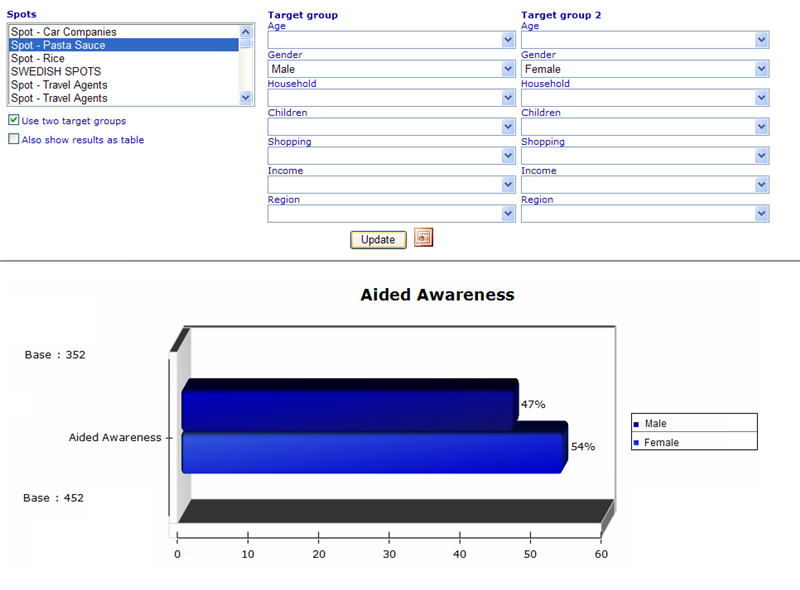Difference between revisions of "Category:Campaign diagram"
(Created page with "Category:Diagrams ===Campaign diagram=== Campaign diagrams compare two different 'campaigns' or one campaign but compared with itself on different filters. Typically ca...") |
(No difference)
|
Revision as of 05:58, 29 March 2011
Campaign diagram
Campaign diagrams compare two different 'campaigns' or one campaign but compared with itself on different filters. Typically campaigns are ads, promotions or other activities which run over a limited period of time and where you would like to compare efficiency and impact! Below is an example of a campaign diagram:
If we choose 'Use two target groups' then we cannot choose multiple 'campaigns/brands' in the left side multi-select box. If not checked then we can choose two - thus comparing two different campaigns. The above example shows one campaign compared on two different filter target groups!
To view the resulting diagram of the filters set up in the filter area you just need to click the update button. If any of the expressions that are used for generating the image return error, then these will be interpreted as null or zero. If you are not sure of what the actual reason is that a value shows null or zero, there are two hidden update buttons that can help you clarify what lies behind the values you are presented to. These are:
Alt+T: Will show your results with actual error messages in the cells that have problems. (Results will only be shown as table when using this 'Update' action)
Alt+P: Will show your results as the expressions that will be made to get the final results. (Results will only be shown as table when using this 'Update' action)
You set up campaign diagrams using the dynamic diagram editor shown below:
To generate a tracking diagram you must/can specify the following information:
Name: A unique name to identify the resource.
Data cache: You must specify where the data for the dynamic diagram is retrieved from.
Monitor path: If you want to use common properties for the diagram you must here choose the name of the monitor resource to which the diagram should be related!
Style sheet: Important to specify how the diagram will look. Especially important is the style sheet definition for setting up free labels.
Diagram type: You can choose to show campaign diagrams as bar line or radar diagrams.
Brand type: Choose between no effect, merge and reverse. The last two are relevant for 2 level bar diagrams. When highlighting two campaigns and viewing we can choose whether items in each campaign will be gathered in one side each (merge) or compared across items (reverse).
Title: Will add a title to the diagram image.
Auto generate: When checked the user will immediately have a diagram shown when entering the dynamic diagram page. Filters will be the default ones set up for the diagram.
Hide criteria area: When checked then the filter/criteria area where user can specify the logic for the diagram to be shown, will by default be hidden when user enters the viewer of the diagram initially. This setting can only be checked if 'Auto generate' is also set to true.
Brands with 2 levels: Please click here to read more on what brands in two levels mean!
Pages in category "Campaign diagram"
The following 7 pages are in this category, out of 7 total.

